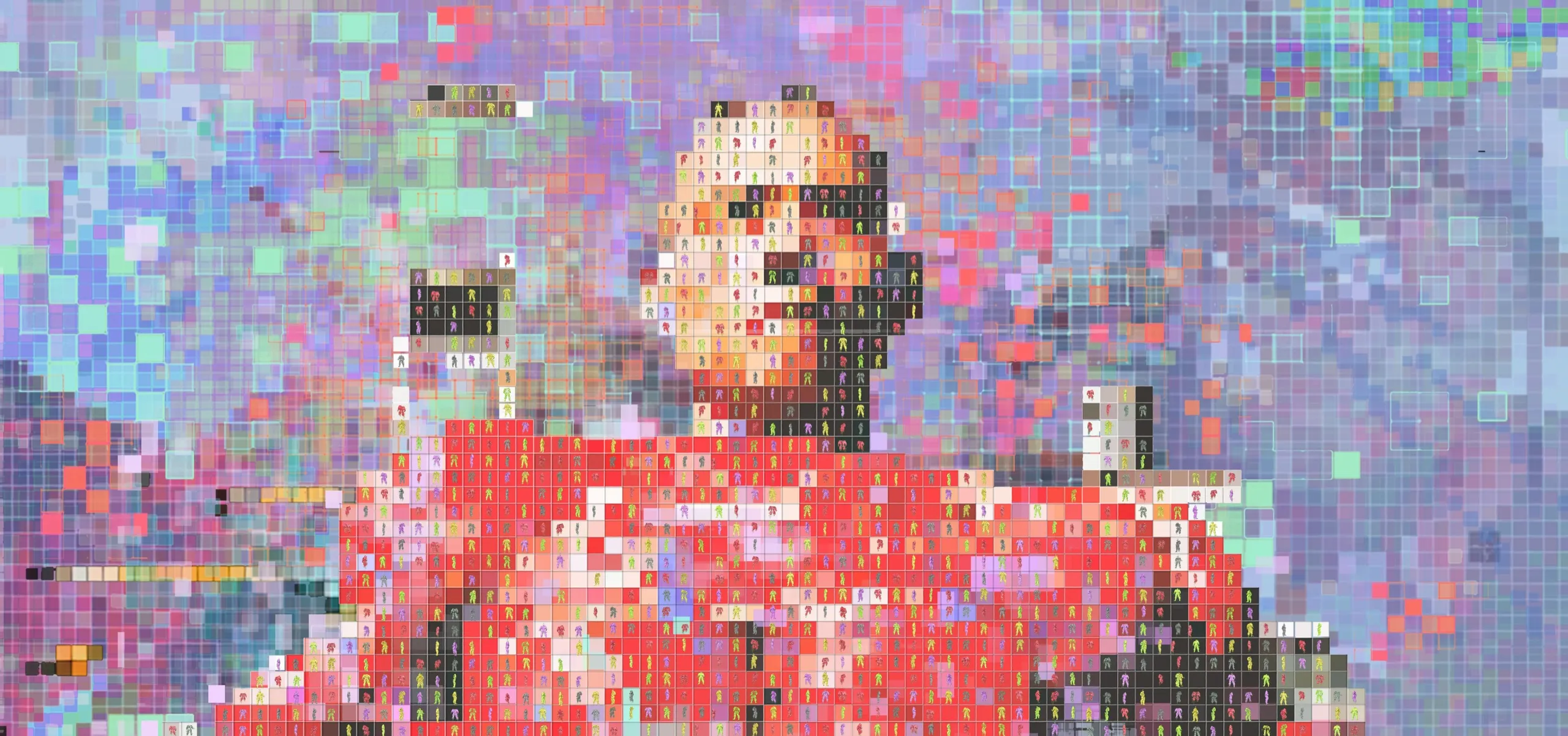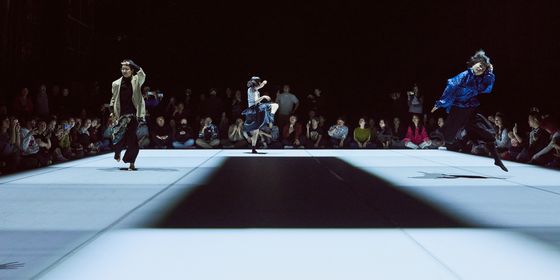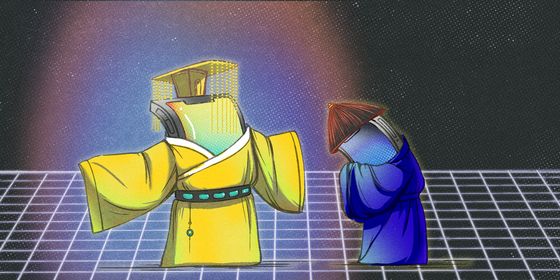In the Chinese NFT world, reputation and connections prove just as important as in the offline traditional art scene
The screen cracks to the sound of exploding gunpowder. A video montage plays, showing canvases facing downward and weighted with stones, bucking like mules as explosives are set off underneath them.
This is the work of Cai Guoqiang, a New York-based Chinese artist famous for using fireworks and gunpowder as a medium, with enough clout to earn his work some airtime in the opening ceremony of the 2008 Olympic Games in Beijing. This video, titled Transient Eternity—101 Ignitions of Gunpowder Paintings, feels more like a behind-the-scenes documentary than actual art. Indeed, it’s a set of shots of Cai making another artwork, a series of canvases titled “Individual’s Journey Through Western Art History.”
But it sold through production studio and NFT sales platform TRLab for 2.5 million US dollars as a Non-Fungible Token (NFT) in July 2021, coveted by influential bidders like Justin Sun, CEO of the digital trading platform TRON.
The sale came at a time, says Audrey Ou, co-founder and CEO of TRLab, when many were keen to experiment with the possibilities of NFTs. “For Cai’s many fans, followers, and collectors, it was an immensely exciting opportunity,” she tells TWOC, with the latest crypto-technology capturing art “designed to exist in ephemeral form.”
By contrast, newer Chinese artists still struggle to sell at auctions at high prices. “I don’t think they can do that if they have less of a reputation,” Chen Qiji, a crypto-artist who works under the name of Ellwood, tells TWOC. Despite having worked in field for the past two years and painstakingly coded his own crypto-art, Ellwood has only sold 0.049 ETH (Ether, a popular crypto-currency), converting to 88.88 US dollars, according to the database CryptoArt.
Ellwood is part of a community of so-called “crypto-native” artists, who typically have a background in computer science and work solely within the world of NFTs, coding, and digital art. Despite working in NFTs for longer, they lack the fans and followers of big names like Cai Guoqiang.
Theoretically, these artists’ in-depth knowledge of the field should give them a head start when it comes to fame and fortune in the digital world. This was certainly the case for many Western crypto-artists: on CryptoArt, the highest-selling NFT artists to date all have extensive experience working exclusively within digital art. These include pak (whose total artwork is valued at 335 million US dollars), Beeple (172 million), and xcopy (60 million).
But for Chinese artists working within the space, it’s a different story: overall, the biggest numbers are being earned by traditional artists only starting to work in NFTs within the past year. “At this point they earn much more than artists from the [Chinese] crypto-native community,” says Fan Yiwen, another crypto-artist who works under the name of Reva.
Ever since the sale of Everydays: The First 5000 Days by crypto-artist Beeple for a record 69 million US dollars in March 2021, all sorts of people and institutions have taken to the internet to create an NFT—either to experiment with a new fashion, or else to get rich quickly.
That includes the blue-chip galleries, museums, and artists that make up the mainstream international art world. “An NFT frenzy is raging,” stated a Wall Street Journal article in April 2021, which related some big-name artists and galleries who were rushing to get into this lucrative, cutting-edge market. In summer 2021, British artist Damien Hirst released 10,000 NFTs for sale, reportedly making 25 million US dollars. Irish artist John Gerrard told ArtNet that he launched his first NFT after just a month’s research, a digitized version of a work from 2017, pricing it at 494,000 US dollars.
Chinese artists who made their names on the global art scene in the 1980s and 1990s have been able to tap into long-standing connections. Cai’s NFT projects with TRLab are “rooted in a decade-long relationship,” says Ou. Cai had extensive experience working with Christie’s auction house and the Rockbund Art Museum in Shanghai (Xin Li-Cohen, one of TRLab’s joint founders, is a deputy chairwoman at Christie’s, while Ou’s family founded Rockbund). According to Ou, when Cai “expressed an interest in extending his physical presence into the digital realm, it was a natural fit for all involved.”
But China came late to the NFT trend. Whereas the well-known and multi-million dollar “CryptoPunks” NFT collection began in June 2017, Reva (one of the pioneers of the Chinese crypto-native community) only found out about it in early 2020.
“It’s to a large extent a Western story, both in terms of content as well as infrastructure,” says a member of GlimmerDAO, a so-called “Decentralized Autonomous Organization” of artists and entrepreneurs from across the world, which invests in NFTs in Asia (they preferred to remain anonymous for this story). Without a Western gallery giving backing, crypto-native Chinese artists have some catching up to do.
Since Transient Eternity TRLab has collaborated on other NFT collections with Cai, such as the digital smoke-like displays of “Your Daytime Fireworks.” This series earned TRLab and Cai 1098.27 ETH—around 3 million US dollars—on the primary market (that excludes the secondary NFT market, where buyers can resell their NFTs to other buyers).
In February this year, Fang Lijun, a traditional artist whose paintings of bald heads made his name in the 1990s, created the “Elemental” NFT series in partnership with the NFT magazine Outland. These NFTs were a series of these heads, images from the world of oil-on-canvas uploaded onto the trading platform OpenSea. The average price on the secondary market is currently 4,899 US dollars per NFT.
There’s also Zhang Huan, a photographer and performance artist born in 1966, who has collaborated with the influential Pace Gallery in NFT creation. The gallery’s NFT platform, Pace Verso, is currently selling NFTs from his series “Celestial Burial of an Artist” at 20,000 US dollars each.
But in the crypto-world, it doesn’t matter how long you’ve been working in the traditional art world. Among crypto-artists, Cai Guoqiang and Fang Lijun would still be considered inexperienced “non-natives” whose work is “just a picture” uploaded as an NFT, according to Liu Jiaying, a crypto-artist and coder who goes by the name CryptoZR.
For CryptoZR, putting traditional art into NFTs makes no artistic sense. Though she tells TWOC she has nothing against traditional artists trying their hands in the world of crypto, for her, creation in the virtual world using materials from the traditional art world—like fireworks, or oil on canvas—would be “inappropriate,” like “scratching an itch through clothes,” as it doesn’t properly grasp the new opportunities the digital medium brings. As examples, she cites artists generating unique and innovative images through the blockchain, from buildings in the metaverse to intricate fractal designs—that is, if they know how to code.
Non-natives’ lack of knowledge about coding and blockchains make them stand out a mile away. Although Reva also tells TWOC she has no problem with non-native artists experimenting with NFTs, “I can just smell them.” According to her, they have usually “taken their friends’ advice to have a try at NFT art, but…don’t have any relationship with the community.”
The “community” is those artists, collectors, and investors who make up the crypto-art scene. They will buy each other’s work, promote exhibitions, attend forums, and generally offer each other support.
That’s not to say Chinese crypto-natives can’t sell well. Reva has generated a total of 102,796 US dollars through combined work, according to CryptoArt. CryptoZR, who began experimenting in crypto-art as early as 2017 during her Masters course at the Central Academy of Fine Arts in Beijing, sold a single artwork, 1000EYE, for 1000 ETH (about 1.9 million US dollars) in September last year, making her the highest-earning Chinese NFT artist to date.
Community was crucial to the success of the work. 1000EYE is a mosaic made up of 1,000 individual eyes that were sold for 1 ETH each. CryptoZR spread the word in advance the work’s release among groups of computer engineers via WeChat groups, Twitter, and a crypto-native web forum called Discord. But she doesn’t know of any other Chinese crypto-artists who have managed to sell for around 1,000 ETH, let alone Cai’s 2.5 million US dollars.
In the world of crypto-art, money and community go hand in hand. Ellwood used Twitter to market his “Journey of Lefand” series, a dream diary using generative art software. He has sold 11 out of 12 of them so far, but it took roughly a year of hustle. If he wants his artwork to be sold, “you have to let people know your work,” he tells TWOC.
Ellwood claims that Decentralized Autonomous Organizations (DAOs) provide a way for young independent crypto artists to create a platform of their own. “They’re like the early Impressionist groups,” he says: lacking the money and the academic connections, but relying on community (sharing information, opportunities, and each other’s work) to bring them some power. “That’s the only thing we can do right now.”
Similarly, Ou points out that the proceeds of Transient Eternity went to good causes within the traditional art community. Half went to the Rockbund Museum and is being used to fund their digital art research programs. The majority of the other half went towards the Cai Fellowship Program, funding young Chinese artists studying in the US.
These days, there are challenges for Ellwood’s group, WeirDAO. Despite the group having 776 followers on Discord, there are only 18 artists actively working within the DAO. Ellwood admits that 18 artists is not much, but also warns that a large number of creative people grouped together, all wanting different things, will be difficult to organize. DAOs can form and collapse quickly, given that each individual has different aims and may have come together for just one purpose.
In the fast-paced world of crypto-art, things can change in a flash. It is still a young industry, gaining mainstream popularity just over a year ago. As the crypto-native field becomes wealthier and more established, perhaps more of its indigenous Chinese artists will, too.
This is the third part of our series on the development of NFTs in the Chinese art world (or “digital collectibles,” as the only legal versions of NFTs are known in China). Part 1 explored how traders operate in China's legally gray NFT market, and Part 2 looked into why many Chinese cryto-artists are only dealing abroad.
Cover Image: Zhang Huan, “Celestial Burial of an Artist #2,” 2021














